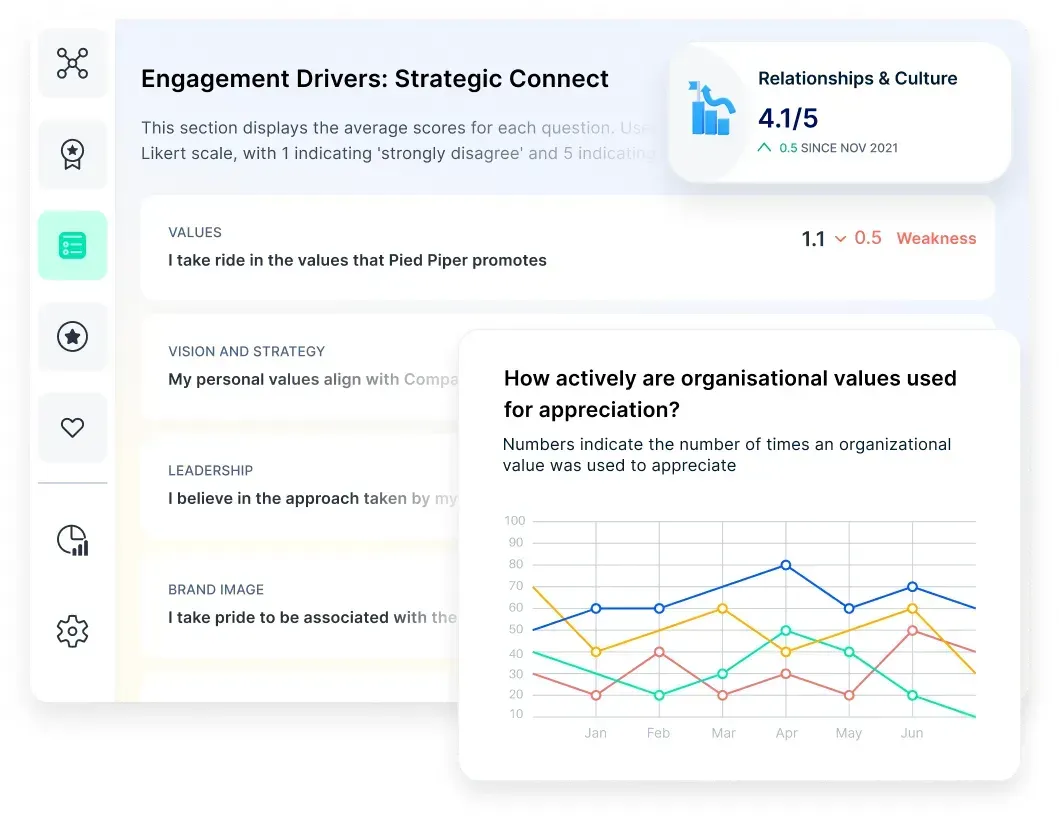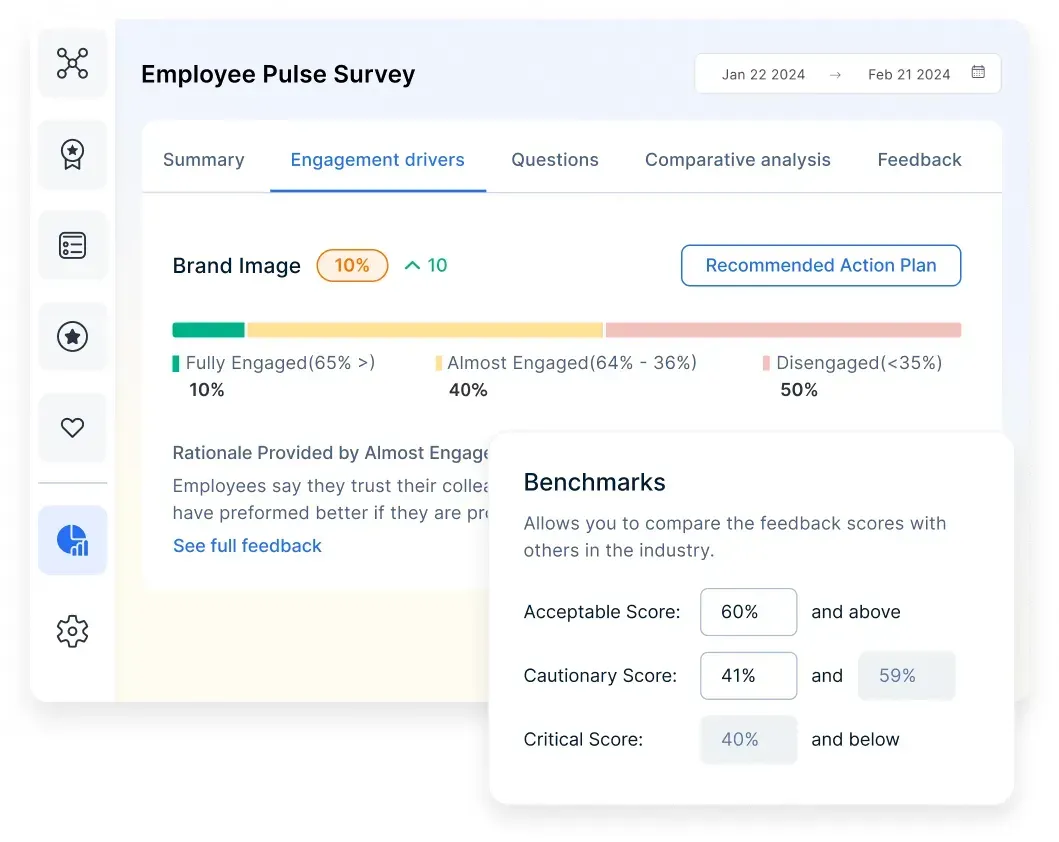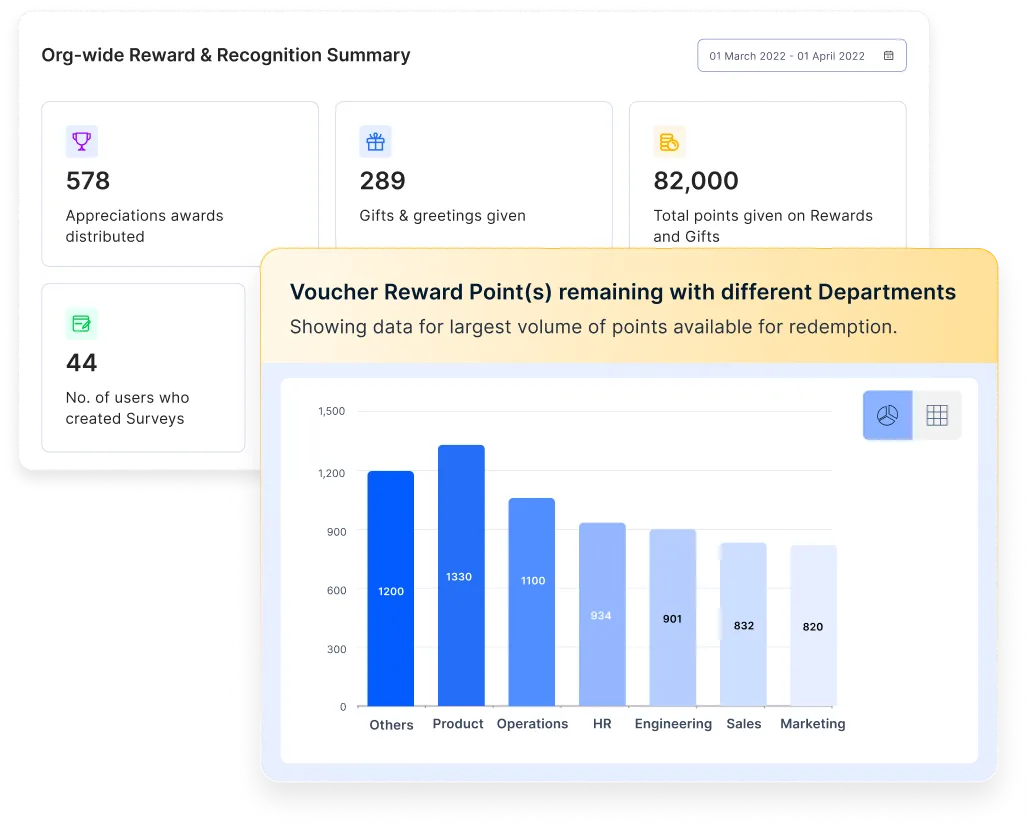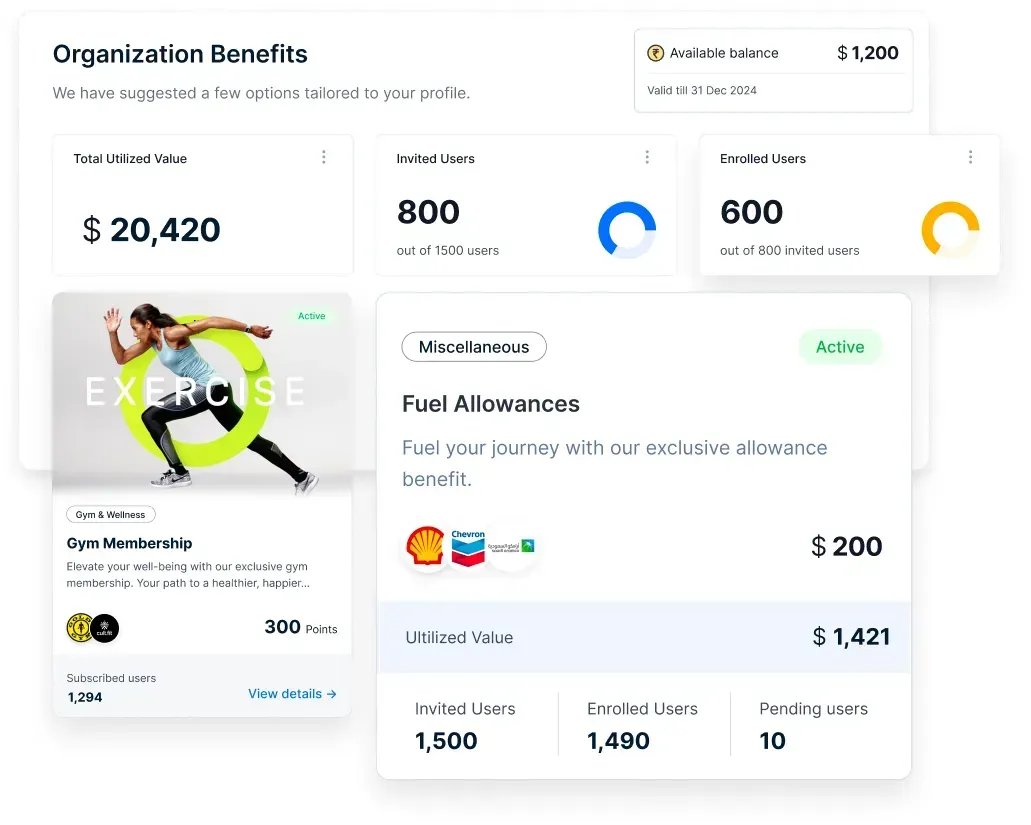7 Ways HR People Analytics Transforms Workforce Strategy
HR people analytics empowers organizations with data-driven insights to enhance workforce planning, boost retention, and improve decision-making for a more efficient HR strategy.
On this page
- What is people analytics?
- Different types of analytics
- The best analytics as a tool
- How is Xoxoday Empuls transforming people analytics with its powerful tools?
- Areas where people analytics is used
- How to build a great people analytics strategy?
- Benefits of people analytics
- Concluding reflections – The path to widespread adoption
- FAQ's
For many years HR was regarded as an errand to ‘hire and fire’ resources, but over the period of time, with the advancements in technology, big enterprises are talking about the possibility to apply big data; which would aid them in making effectual decisions regarding the welfare of their employees and the organization.
For this, organizations have started to show interest in people analytics and invest in it. Let us understand what is people analytics and how it empowers HR?
Human Resource programs no longer need to be based on “soft” reasoning but should be as analytical and data-driven as any other management discipline - Chris Argyris.
The role of an HR consultant has changed. HR is no longer a ‘soft task’ or a ‘people’s person.’ The pace of technological developments has directed HR professionals to be more business-centric and tech-savvy.
Amongst other technological augmentations like AI in HR, Virtual Reality, Automation, Gamification, Cloud-based HR systems has had a major impact on HR professionals and has taken the HR world by a typhoon, transfiguring the way HR operates.
With the pervasive adoption of cloud HR systems, more organizations are financing programs to use data for all aspects ranging right from workforce planning to people decisions and operational enhancement.
As well stated by Joash Narainsamy, Organisational Wellness Specialist at ICAS Southern Africa.
“Workplace analytics can give insight into Absence Management, Presenteeism (present but unproductive), Talent Acquisition and Retention, Fatigue and Accident Management, and tell you exactly where your business is bleeding and what to do about.”
What is people analytics?
People analytics is the process of scrutinizing the available people-related data to measure the HR programs' efficiency and identify patterns to make profound business decisions.
In simple words, we can say that it is a process that refers to the technique of analytics that uses technology, statistics, and proficiency to enormous sets of talent data which helps the management to make effective business decisions for the organization as well as for their employees thereby having the opportunity to get a better return on their investment in the business as well as in the people whom they employ.
↠ 71% of companies regard people analytics as a topmost priority.
↠ 31% of companies rate it as very important.
↠ 8% of organizations stated that they have usable data.
↠ 9% believe they have a good understanding of which talent dimensions drive performance in their organization.
According to SHRM Research:
↠ 94% of business leaders believe that people analytics enhances the HR profession.
↠ Additionally, 71% of HR executives using people data analytics consider it essential to their organization’s HR strategy.
Analytics is applied to a vast array of business operations and their challenges. Recruitment is considered the first and foremost area, followed by other areas such as workforce planning, measuring the employee’s performance, compensation benefits, and retention.
Organizational network analysis (ONA) and “interaction analytics” are widely used to study employee behavior to detect new prospects for business improvement.
Different types of analytics
According to Gartner’s Business Analytics Maturity Model, four defined types of analytics are broadly used. They are descriptive analytics, diagnostic analytics, predictive analytics, prescriptive analytics. Let's understand these in detail.
1. Descriptive analytics
Just as beams or foundation walls are considered the base of a building similarly, Descriptive Analytics is considered the base footing of the business intelligence.
It is a primary data processing stage that forms a synopsis of historical data to supply helpful information and probably prepare the data for further analysis. It mainly focuses on the question ‘what happened’ on issues related to employee turnover, number of openings, time to hire, new hire report, etc.
2. Diagnostic analytics
We form a detailed outline of what happened when we did a case study. After we investigate what happened, we tend to dig deep to know why it happened. Similarly, the diagnostic analysis focuses on why did it happen? It digs right into the depths of the data to understand the causes of a particular behavior or event.
3. Predictive analytics
It is a twig of advanced analytics used to identify and project information about the unknown future. Possibilities and trending events. It comprises many statistical techniques ranging from predictive modeling, machine learning, data mining, and artificial intelligence that analyze current data and historical facts to make projections about the future. The outlines found in the past and transactional data can be utilized to detect future risks and opportunities.
4. Prescriptive analytics
It is a zone of business analytics, and it focuses on proposing possible measures to direct towards a solution or a viable outcome. It is associated with both descriptive and predictive analytics. As descriptive analytics seeks to provide insight into what happened, predictive analytics aids in predicting what might happen.
Prescriptive analytics uses artificial intelligence and machine learning to understand the impact of the future. It aims to provide the best strategies based on those situations, thereby aiding enterprises to mitigate forthcoming risks or suggest the best possible options to enterprises to take advantage of the future opportunity. Prescriptive analytics is used in industries such as travel, oil, and gas, transportation, etc.
The best analytics as a tool
Predictive Analytics can be considered an astounding tool for business enterprises among the above-mentioned four analytics. The reason for this is that it has the capability to give meaningful perceptions into areas such as talent management, employee benefits, and promotions or helps in predicting information about the unknown future happenings.
Google uses employee performance data to compute suitable interference times to facilitate high-performing and low-performing employees' success. If you want the same result as Google, opt for Xoxoday Empuls.
How is Xoxoday Empuls transforming people analytics with its powerful tools?
Xoxoday Empuls empowers organizations with human analytics, providing data-driven insights into workplace culture, employee engagement, rewards, and perks. By analyzing people data analytics, HR leaders can optimize strategies, improve communication, and foster a thriving workforce.
1. Culture & values: Strengthening alignment and inclusivity

Track how well employees embrace core values through people analytics on values-based recognition. Monitor active discussions and sentiment trends to enhance collaboration. Use Xoxoday Empuls surveys to gauge cultural perception, identify gaps, and take proactive measures. Assess key aspects like DEI with measurable insights to build a more inclusive workplace.
2. Employee engagement: Driving performance and retention

Measure engagement, loyalty, and workforce sentiment with eNPS and Pulse surveys. Leverage people data analytics to uncover trends in attrition, motivation, and team dynamics. Compare engagement levels with industry benchmarks and use actionable insights to strengthen retention strategies.
3. Reward & recognition: Fostering a culture of appreciation

Analyze recognition trends across departments and locations to improve adoption and impact. Evaluate award effectiveness, monitor reward distribution, and track redemption patterns. Gain real-time insights into budget allocation, pending nominations, and overall rewards utilization for smarter decision-making.
4. Perks & wellbeing: Enhancing financial security

Track cost savings at both individual and organizational levels through employee perks. Provide employees with clear insights into monthly savings, enabling better financial planning. By leveraging recruiting people analytics, optimize benefits to attract and retain top talent.
Xoxoday Empuls enables HR teams to make data-driven decisions, using people analytics to enhance workplace culture, engagement, and rewards for a more motivated workforce. Schedule a call now to know how Xoxoday Empuls can help you out!
Areas where people analytics is used
The development of people analytics is worldwide and not limited to a particular country. It has its usage within the HR domain and the business framework. The areas of its users are likely to develop diversely in the coming years.
People analytics can be leveraged in several ways to enhance the functioning of a company. To name a few areas where people analytics are/can be used within the enterprise are:
- Talent acquisition
- Picking up the right applicant to minimize bias in hiring
- Increasing employee engagement
- Workforce readiness
- Measuring work culture, employee experience, and employee retention.
However, HR areas such as recruitment, employee retention/turnover, and employee performance are the core areas where analytics can be used, and the organization can reap its benefits.
1. Recruitment
The skills of application stalking procedure have changed the recruitment procedure. The judgment could be biased after interviewing the applicant irrespective of how accurately the information pertaining to the applicant is presented. As stated by Sujee Saparamadu, Orange HRM CEO, in an interview with Better Buys,
“When you do small talk before the interview, this leads to subconscious hiring on a confirmation bias. That’s where personality insight comes into the picture.”
To curb bias when working through a recruitment process, people analytics can be used as a helpful tool to conduct the applicants' relevant assessments. The clarity in terms of data about the candidate’s traits can serve for other comprehensions, such as whether the candidate’s behavior and personality traits would be appropriate with the organization’s culture or not.
Additionally, if all the data about the candidate is saved and being managed in a recruitment CRM software, it makes life easier for HRs to compare candidates and shortlist the best ones effortlessly.
2. Employee performance
Employee performance is where predetermined notions and prejudices are difficult to jiggle. People analytics allows HR to recognize probable fissures amongst employees within a particular department/team and what training and guidelines are required to compress and seal those fissures.
An in-depth digging into the information will give organizations a gist of who will be a high and low performer amongst the freshly hired applicants. This will help managers empathize, effectively get involved, and encourage employees to enhance the organization's overall progress.
3. Employee turnover
The use of people analytics helps to identify the ratio of employee retention. By collecting several data and penetrating deep into the available information, an enterprise can observe employees’ behavior and ascertain the behaviors of employees who are about to leave/are leaving the company against employees loyal to the company.
Just as business determines what drives consumers buying decisions similarly, such type of understanding lets HR get a fair idea as to what is the reason that makes an employee leave an organization and vice-versa.
Rather than banking on gut feeling, it is much better to bank on proof-based insights. This will help HR to make effective decisions to enhance employee retention.
How to build a great people analytics strategy?
Explore these seven steps to building a great people analytics strategy:
1. Seek aid from a business trailblazer
The function (people analytics) should be capable enough to provide global support and not just technical analysis. It should be fit enough to identify the right problems that pop in during the business processes.
One should seek help and support from stakeholders, IT resources, senior executives, and not to forget business trailblazers.
2. Establish a powerful analytics team
The success of people analytics relies on and comprises teams across all segments of business such as finance, HR, etc., and data traversing the functions. It is important to build and establish a strong, closely-knit multi-functional expertise team proficient with data calculations, data visualization, institutional knowledge, and advisory skills so that the team develops as the enterprise’s analytics team.
3. Gather reliable data-driven HR
Accurate data is the foundation of all analytic practices. The accuracy of the analyses depends upon how good data is fed into the software. One has to invest in money, time, and execution of actionable insights drawn from analytics to get the best out of people analytics.
What step needs to be taken is essential to decide upon once the organizations discover the causes of the problem through the evaluation process obtained from the statistical data.
Appropriate steps should be taken to ensure that data quality is a part of every analytics conversation. Avoid using irrelevant data as it leads to an interpretation of wrong conclusions and creates data turbulence.
4. Enhance analytics fluency
To choose a right to follow up the action, one must be intelligent enough to understand and interpret complicated data. For this, enterprises must implement and provide training on data governance programs that would provide training in implementing standard tools, standardization of reports and dashboards, etc., and prepare a cluster of important managers and knowledgeable HR stakeholders.
5. Develop a roadmap for investment in analytics programs
Develop an analytics investment roadmap for a wide rainbow of analytics. Investments should be endeavored at constituting a new business operation for the organization and not merely a technical team within HR.
6. Emphasize on actions and not merely findings
To add value to people's analytics program, the analytics team should be capable enough to understand the root cause of the problem from the provided information and provide the best and most appropriate solution.
7. Create a data plan
People analytics banks on the bisection of data from business operations, HR, and outer sources. So, it is necessary to establish a data plan to align/amalgamate the organized and unorganized data from both in-house and outer sources.
Benefits of people analytics
The constantly changing business environment has made people analytics important. To support this fact, here are the benefits of using people analytics:
1. Strengthen decision making
People analytics allows you to collect information from vast data sources that help make effective decisions. When it comes to making decisions, traditional HR was subjective.
With the introduction of people analytics, subjective decision-making has ended. People analytics gives you statistical data that helps you understand the problem and make effective decisions to curtail the problem.
2. Enhances retention
Losing an existing employee can be pricier for an organization than hiring a new applicant. People analytics helps you to enhance employee retention. As mentioned above, predictive modeling is useful and plays an important role in the future.
Predictive analytics helps management know which employees are about to leave/are leaving the organization. With this information on hand, they can take proactive steps to retain the employee and encourage them to stay with the organization.
3. Drives accountability
Data presentation is a vital part of people analytics calculation. Accepting people analytics means accepting a world of easy, pertinent data visualization. Such statistical data is easily interpretable and can be understood in the context of strategic business goals. This clarity boosts accountability, as employees take control of the data.
Accountable employees perform better and are considered more of a business asset. Finding ways to drive accountability has been the biggest challenge, and people analytics has let accountable employees meet that challenge.
4. Increases employee satisfaction
Employee engagement has been a major issue in HR. Contented employees are more productive, well-organized, and more faithful to the organization they work with.
People analytics can have a good impact on employee satisfaction. With people analytics, management can get an idea about how employees feel about working in their current organization.
5. Hire better people
One of the biggest benefits of people analytics is hiring better and suitable candidates for a given position. People analytics helps you develop a predictive evaluation for performance based on the current top performers of the organizations.
Organizations can use this knowledge while evaluating applicants to make sure they hire those applicants that are most likely to perform within their business.
6. Saves time
From sourcing to hiring and training to nurturing the talent is a time-consuming activity and all the time and efforts go in vain in wrong placements. With people analytics, employers get an idea about which people and programs are worth their time and which are not.
As a result, people analytics gives you additional time to spend on the things that direct business-driven results.
Concluding reflections – The path to widespread adoption
Many organizations have to constitute decent and reliable people analytics functions still. Those enterprises who have are fuelling ahead, and these organizations have not restricted the functioning of people analytics only to the HR domain; but have extended people analytics function to work across all segments of the business, including finance, HR, and business operations, to reap the benefit of the function’s powerful impact on the business performance.
People analytics is set to be a nucleus element of the future of HR, and those enterprises that put employee belief and confidentiality at the midpoint of their endeavors will eventually be the ones that reap the most value. It’s geared up to be an electrifying road ahead.
FAQ's
What is the scope of people analytics?
The scope of people analytics covers workforce optimization, talent acquisition, employee performance, engagement, retention, DEI initiatives, and overall HR strategy improvement through people data analytics.
What is another name for people analytics
People analytics is also known as human analytics, workforce analytics, HR analytics, or talent analytics.
What is the difference between HRIS and people analytics?
HRIS (Human Resource Information System) is a system that stores and manages employee data, such as payroll, attendance, and benefits. People analytics, on the other hand, analyzes this data to generate insights that help improve workforce planning, engagement, and decision-making.
What are the 7 pillars of people analytics?
The seven pillars of people analytics include:
- Workforce planning
- Talent acquisition and recruiting people analytics
- Employee engagement and experience
- Performance management
- Learning and development
- Diversity, equity, and inclusion (DEI)
- Employee retention and attrition


















